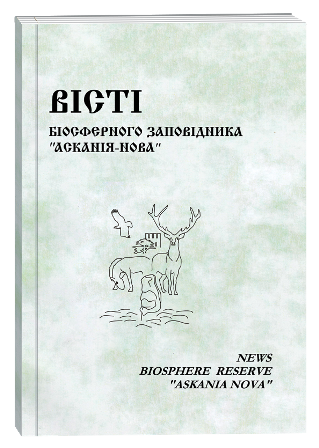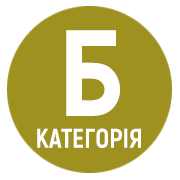HELMINTOFAUNA OF TURKMENIAN KULAN IN THE ZOO OF THE BIOSPHERE RESERVE "ASKANIA NOVA"
DOI:
https://doi.org/10.53904/1682-2374/2022-24/18Keywords:
Мультимодальна структура, стронгіліди, гельмінтофауна, Equus hemionus kulanAbstract
The helminthological material collected post mortem during 1986–2018 from 19 individuals Turkmenian kulans from the "Askania-Nova" zoo was analyzed. 37 species of helminths were identified: 2 species of cestodes and 35 species of nematodes, including 30 species of strongylids, of which 7 species belong to the suborder Stron-gylinae and 23 species belong to the suborder Cyathostominae. The intensity of infestation of one kulan individual was an average of 2416,0 specimens. The most numerous species is the stomach nematode Habronema microstoma (Spirurata: Habronematidae) – a biohelminth whose intermediate host is the blowfly Stomoxys spp. (Diptera: Muscidae); the intensity of invasion is 1610,9 speci-mens/individual, the extent is 73,7%. Cyathostomum catinatum (624,6 specimens/individual; 63,1%) and Strongylus vulgaris (268,4 specimens/individual; 94,7%) dominate among the stron-gylids. The formation of strongyloid aneurysms in the vessels of the mesentery increases with age (58,1% – animals older than two years); the majority (59,2%) is registered in the autumn-winter period. The zooanthropogenic species of nematode Trichostrongylus axei (Strongylida: Trichostron-gylidae) was found in the stomach of only kulans from all equine species of the "Askania-Nova" zoo (83,5 specimens/individual; 10,5%). Two rare species of cyathostomines, Cyathostomum tetra-canthum and Cylicocyclus ultrajectinus, were recorded in the helminth fauna of kulan for the first time. Dictyocaulosis (Dictyocaulosis), which is caused by the pulmonary nematode Dictyocaulus arnfieldi (Strongylida: Dictyocaulidae) is a characteristic disease of kulan (132,6 specimens/indi-vidual; 47,4%). In addition, parafilariosis (Parafilariosis) occurs only in kulans among the horses of the Askania-Nova zoo, the causative agent of which is the nematode Parafilaria multipapillosa (Fi-laria: Onchocercidae), the intermediate feeder is the blood-sucking fly Haematobia atripalpis (Dip-tera: Muscidae), and the main place localization – subcutaneous tissue in the nape of the neck. The structure of the helminth fauna of the Turkmen kulan in Askania-Nova is of a multimodal type with the inclusion of dominant (1), subdominant (7), background (16) and rare (13) species, which is typical for wild animals.
References
Байтурсинов К. К. Факторы формирования общности гельминтофауны диких и домашних копытных Казахстана. Российский паразитологический журнал. 2008. № 4. С. 5–12.
Двойнос Г. М., Харченко В. А. Стронгилиды домашних и диких лошадей. Киев : Наукова думка, 1994. 234 с.
Ивашкин В. М., Двойнос Г. М. Определитель гельминтов лошадей. Киев : Наукова думка, 1984. 162 с.
Соломатин А. О. Кулан. Москва : Наука, 1973. 145 с.
Котельников Г. А. Гельминтологические исследования животных и окружающей среды. Москва : Колос, 1984. 238 с.
Кузьмина Т. А., Харченко В. А., Старовир А. И., Двойнос Г. М. Применение метода диагностической дегельминтизации для изучения кишечных гельминтов лошадей. Вестник зоологии. 2004. Т. 38, № 5. С. 67–70.
Кузьмина Т. А., Звегинцова Н. С. Прижизненные исследования стронгилид (Nematoda: Strongylidae) туркменских куланов заповедника "Аскания-Нова", Украина. Паразитарные болезни человека, животных и растений : труды VI Междунар. научно-практич. конф. Витебск, 2008. С. 252–256.
Скрябин К. И. Метод полных гельминтологических вскрытий позвоночных, включая человека. Москва : Изд-во 1-го МГУ, 1928. 45 с.
Уркхарт Г. М., Эрмур Дж., Дункан Дж., Данн А. М., Дженнингс Ф. В. Ветеринарная паразитология. Пер. с англ. Болдырева Е., Минаева С. Москва : Аквариум ЛТД, 2000. 352 с.
Bucknell D., Hoste H., Gasser R. B., Beveridge I. The structure of the community of strongyloid nematodes of domestic equids. J. Helminthology. 1996. Vol. 70, N 3. P. 185–192. Dvojnos G. M., Kharchenko V. A., Zvegintsova N. S. The characteristics of the helminth community in the Turkmen kulan (Equus hemionus). Parazitologiia. 1992. Vol. 26, N 3. P. 246–251.
Herd R. P. Performing equine fecal egg counts. Vet. Medicine. 1992. Vol. 87. P. 240–244.
Lichtenfels J. R. Helminths of Domestic Equids. Proc. Helm. Soc. Wash. 1975. Vol. 42. P. 1–92. Kaczensky P., Lkhagvasuren B., Pereladova O., Hemami M., Bouskila A. 2015. Equus hemionus. The IUCN Red List of Threatened Species 2015: e.T7951A45171204.
Kuzmina T. A. Kharchenko V. A., Starovir A. I., Dvoinos G. M. Analysis of the strongylid nematodes (Nematoda: Strongylidae) community after deworming of brood horses in Ukraine. Vet. Parasitology. 2005. Vol. 131. P. 283–290.
Kuzmina T. A., Kharchenko V. A., Zvegintsova N. S. Comparative study of the intestinal strongylid communities of equidae in the Askania-Nova biosphere reserve, Ukraine. Helminthologia. 2007. Vol. 44, N 2. P. 62–69. Kuzmina T. A., Zvegintsova N. S., Zharkikh T. L. Strongylidae community structure of the Przewalski᾽s horses (Equus ferus przewalskii) from the Biosphere reserve "Askania-Nova", Ukraine. Vestnik zoologii. 2009. Vol. 43, N 3. P. 209–215.
Osterman Lind E., Eysker V., Nilsson O., Uggla A., Hoglund J. Expulsion of small strongyle nematodes (cyathostomin spp.) following deworming of horses on a stud farm in Sweden. Vet. Parasitology. 2003. Vol. 115. P. 289–299. Tolliver S. C. A Practical Method of Identification of the North American Cyathostomes (small Strongyles) in Equids in Kentucky. University of Kentucky, Depart. of Vet. Science, 2000. 40 р.
Yasinetska N. I., Zharkikh T. L., Zvegintsova N. S. Conservation and breeding of the kulan in Ukraine. Der Zool. Garten. 2002. V. 72, N 4. S. 225–237.







